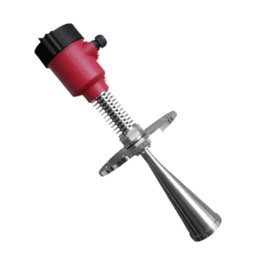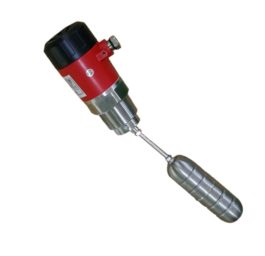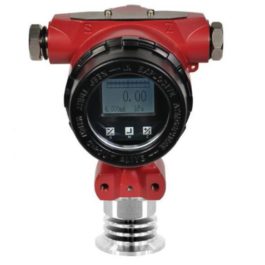Additional information
| Weight | 3 lbs |
|---|---|
| Dimensions | 12 × 12 × 12 in |
| Size | 2", 3" |
| Connection end | Flanged, Threaded, Triclamp |
| Classification | Explosion Proof, Intrinsically Safe |
| Voltage | 120 / 208 VAC, 24 VDC |
| Remote Diaphragm | None, 2", 3" |
Price range: $ 845.00 through $ 1,245.00
| Weight | 3 lbs |
|---|---|
| Dimensions | 12 × 12 × 12 in |
| Size | 2", 3" |
| Connection end | Flanged, Threaded, Triclamp |
| Classification | Explosion Proof, Intrinsically Safe |
| Voltage | 120 / 208 VAC, 24 VDC |
| Remote Diaphragm | None, 2", 3" |
| Ranges | 0.25 mbar - 7.5 mbar 1.2 mbar - 62.3 mbar 6.2 mbar - .62 bar 24.9 mbar - 2.49 bar .20 bar - 20.6 bar |
| Diaphragm Material | 316L SST, Alloy C-276, Alloy 400 |
| Temperature Limits | Ambient: -40 to 185 F Storage: -50 to 230 F |
| Communication Options | Modbus RTU, HART |
| Output Options | 4-20MA, 0-10vdc |
| LCD | Yes |
Q: What is an ultrasonic level transmitter?
A: An ultrasonic level transmitter is a device used to measure the level of liquids or solids in tanks, vessels, or pipelines using ultrasonic sound waves.
Q: How does an ultrasonic-level transmitter work?
A: Ultrasonic level transmitters emit high-frequency sound waves that travel through the air and are reflected when they encounter the surface of the material being measured. By measuring the time taken for the sound wave to return, the transmitter calculates the distance to the material, thus determining the level.
Q: What are the advantages of using ultrasonic-level transmitters?
A: Some advantages include non-contact measurement, making them suitable for various applications, high accuracy, versatility in measuring different materials, ease of installation, and resistance to harsh environmental conditions.
Q: What are the typical applications of ultrasonic-level transmitters?
A: Ultrasonic level transmitters are commonly used in industries such as water treatment plants, chemical processing, oil and gas, food and beverage production, wastewater management, and pharmaceutical manufacturing to monitor and control liquid levels.
Q: How do ultrasonic level transmitters differ from other level sensing technologies?
A: Ultrasonic level transmitters offer non-contact measurement capabilities, making them suitable for applications where contact-based sensors are not ideal due to factors such as material corrosiveness, varying material densities, or environmental considerations.
Q: What factors should be considered when selecting an ultrasonic-level transmitter?
A: Factors to consider include the material being measured (liquid or solid), the required measurement range, the environmental conditions (temperature, pressure, humidity), mounting options, output signals compatibility, and any specific application requirements.
Non-contact measurement: Ultrasonic level transmitters don’t require direct contact with the material being measured, making them ideal for applications where contact could be challenging or undesirable.
High accuracy: Ultrasonic technology provides precise measurements, ensuring reliable level monitoring and control.
Versatility: Ultrasonic-level transmitters can be used for a wide range of materials, including liquids and solids, making them adaptable to various industries and applications.
Easy installation: These transmitters are typically easy to install and require minimal maintenance, reducing downtime and operational disruptions.
Suitable for harsh environments: Ultrasonic-level transmitters are often designed to withstand harsh conditions, such as extreme temperatures, providing durability and reliability in challenging settings.
Limited to clean environments: Ultrasonic transmitters may be affected by dust, vapors, or other obstacles that can interfere with signal accuracy, requiring proper calibration and maintenance.
Signal interference: External factors like temperature variations, air turbulence, or acoustic noise can impact the accuracy of ultrasonic measurements, necessitating careful consideration of the installation location.
Material compatibility: Certain materials may absorb or reflect ultrasonic waves differently, affecting measurement accuracy, particularly in environments with foaming liquids or uneven surfaces.
Cost: Ultrasonic level transmitters can be more expensive compared to some other level sensing technologies, which could be a consideration for budget-constrained applications.
Background noise: Ultrasonic transmitters may be susceptible to interference from background noise or vibrations, requiring proper installation and settings to mitigate potential issues.
Ultrasonic level transmitters find applications across various industries where accurate and reliable level measurements are critical. Some common applications include:
Ultrasonic level transmitters are used for monitoring and controlling the level of liquids and chemicals in storage tanks, process vessels, and reactors. They ensure precise inventory management, prevent overfilling or underfilling, and help optimize production processes.
These transmitters play a crucial role in measuring the levels of water, chemicals, and sludge in treatment plants. They help manage tank levels, automate pumping systems, and monitor the efficiency of various treatment processes.
Ultrasonic level transmitters are employed in oil refineries, offshore platforms, and storage tanks to measure the levels of crude oil, refined products, and chemicals. Not only-but also, accurate level monitoring is necessary for efficient inventory management and safe operations.
Ultrasonics are used for measuring and controlling the levels of ingredients, liquids, and beverages in storage vessels, fermentation tanks, and processing equipment. They ensure accurate batching, blending, and inventory management in food and beverage production.
These transmitters are utilized in pharmaceutical manufacturing and bioreactors for measuring the levels of liquids, gases, and cell cultures. They help maintain precise process control, optimize yields, and ensure batch consistency.
Ultrasonic level transmitters are employed in power plants to measure the levels of water, coolant, and various chemicals in boilers, cooling towers, and fuel storage tanks. Accurate level monitoring is crucial for safe and efficient power generation.
These transmitters are used in mining operations to monitor the levels of liquids, slurries, and ores in storage tanks, flotation cells, and thickeners. Next, they help optimize ore processing, prevent overflows, and ensure efficient mineral recovery.
Ultrasonic measurements are utilized in environmental applications such as monitoring water levels in rivers, lakes, and dams. They provide data for flood control, irrigation management, and environmental impact assessments.
Ultrasonic level measurements are employed in various manufacturing processes, such as automotive, plastics, and textiles. Also, They help monitor the levels of raw materials, chemicals, and finished products in storage tanks and process vessels.
These transmitters find applications in agricultural sectors for measuring water levels in irrigation systems, tanks, and reservoirs. They assist in efficient water management, enabling precise irrigation control and water conservation.
These are just a few examples of the wide range of applications for ultrasonic-level transmitters. Their versatility and ability to provide accurate and reliable level measurements make them indispensable tools in numerous industries where precise level monitoring and control are essential.


